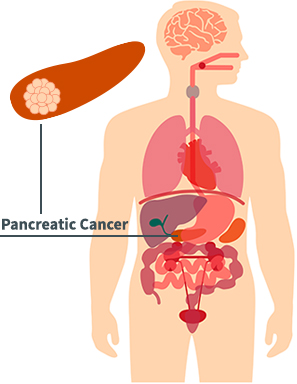About The Condition
 The pancreas is part of your digestive system and sits right below and behind your stomach. It produces an enzyme-containing liquid that is released into the intestines to help your food digest. Pancreatic cancers fall into two categories: exocrine tumors, the most common, and endocrine tumors, also called islet cell tumors.
The pancreas is part of your digestive system and sits right below and behind your stomach. It produces an enzyme-containing liquid that is released into the intestines to help your food digest. Pancreatic cancers fall into two categories: exocrine tumors, the most common, and endocrine tumors, also called islet cell tumors.
There are several types of pancreatic cancer, including:
Pancreatic adenocarcinoma. This starts in gland cells and may be called acinar cell carcinoma.
Solid pseudopapillary neoplasms. These slow-growing tumors often occur in young women and can spread to other parts of the body.
Ampullary cancer. This cancer forms where the bile duct and pancreatic duct come together. While not technically cancer, it is treated the same way as other pancreatic cancers.
Pancreatic neuroendocrine tumors. Also called islet cell tumors, these tumors can be benign or cancerous. Some make hormones that are released into the blood and cause symptoms. When this happens, they are called functioning tumors and may include gastrinomas, insulinomas, glucagonomas, somatostatinomas, VIPomas or PPomas.
Non-functioning tumors. While these tumors don’t make enough hormones to cause symptoms, they are more likely to be cancer than functioning tumors.
Before Surgery
Prior to your surgery for pancreatic cancer, you may have radiation or chemotherapy to reduce the size of your tumor. Please ask your physician about these treatments.
In addition you may be asked to:
- Stop smoking for one month prior to your surgery. Nicotine decreases blood flow, prevents healing after surgery and increases your risk of infection.
- Increase your activity. Aim for 30 minutes of walking or other aerobic activity daily to build strength.
- Improve your nutrition. Add protein supplements such as Boost or Ensure to help your body heal after surgery.
- You will need to do a bowel prep before your surgery. You will receive more detailed instructions from your surgery team.
Please ask your physician about any additional steps you should take before your surgery.
Surgery
Our surgeons perform open surgery, as well as minimally invasive surgeries, for pancreatic cancer. Your surgeon will explain your particular procedure in more detail.
Minimally invasive surgery. Minimally invasive surgery is performed with traditional laparoscopy or robot-assisted surgery using the da Vinci Surgical System.
- Laparoscopic surgery. Laparoscopic surgery requires only a few small incisions into which your surgeon will fit long, thin surgical instruments and a tiny camera. The camera will provide images to guide the surgeon during the procedure.
- Robotic surgery. Some laparoscopic surgeries may be performed using the da Vinci Surgical System. This robotic option gives your surgeon a magnified 3D high-definition view inside your body. The system also enables the surgeon’s hand movements to be translated into precise movements of small instruments inside your body.
Open surgery. With open surgery, your physician will make an incision at the site of the abnormality large enough so he or she can see and touch your internal organs while operating. Your condition may require a Whipple procedure, which removes the head of the pancreas, first part of the small intestine, gallbladder, distal part of the bile ducts and sometimes part of the stomach. The bile ducts, pancreas and stomach are then reconnected to the small intestine to enable digestion to occur. This is more extensive surgery and requires a longer recovery time.
After Surgery
- You will be encouraged to walk to prevent blood clots, muscle weakness and constipation.
- You may experience constipation. If so, you may take a laxative such as Miralax or Milk of Magnesia.
- Ice may help to reduce the swelling for the first 48 to 96 hours. Then use heat to ease muscle soreness and relax tight muscles.
- Ask your surgeon before taking ibuprofen. A small amount of bleeding or drainage is expected from the wound during the first one or two days.
- You may shower one or two days after surgery, but avoid baths, hot tubs, soaking or swimming for two weeks.
- Always talk to your surgeon about weight restrictions and return-to-work options.
- If you have had a Whipple procedure, you may stay in the hospital for up to 10 days, depending on your particular situation. Some people also require time in a rehab center before going home in order to regain strength.
- Surgical drains will be left in place after surgery to remove extra fluid and protect the anastomosis.
- You may need to take supplemental pancreatic enzymes to aid your digestion. In some cases, patients also require insulin after surgery.
- Most patients who have had laparoscopic or robotic surgery are discharged the day following surgery.
- You will be asked to see your surgeon in one to three weeks after surgery.
- If you notice a fever greater than 101 degrees Fahrenheit or drainage from your wound, let your surgeon know by calling 763.780.6699.
- You may be referred to an oncologist for follow-up after surgery.
If you have additional questions, please contact us at 763.780.6699.

